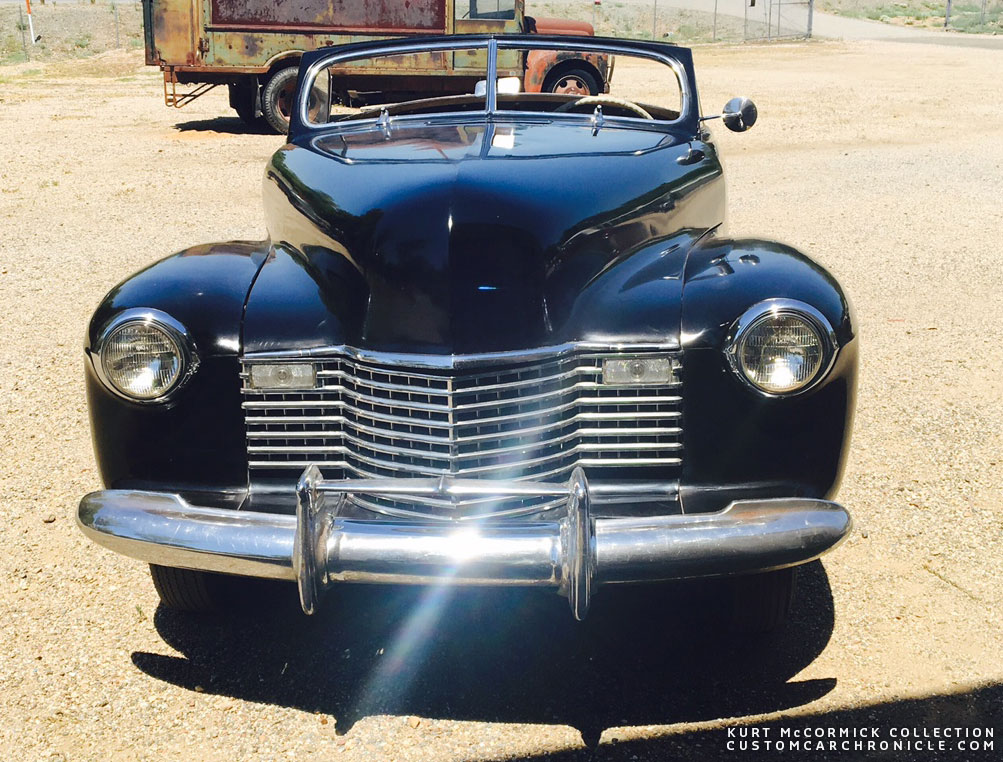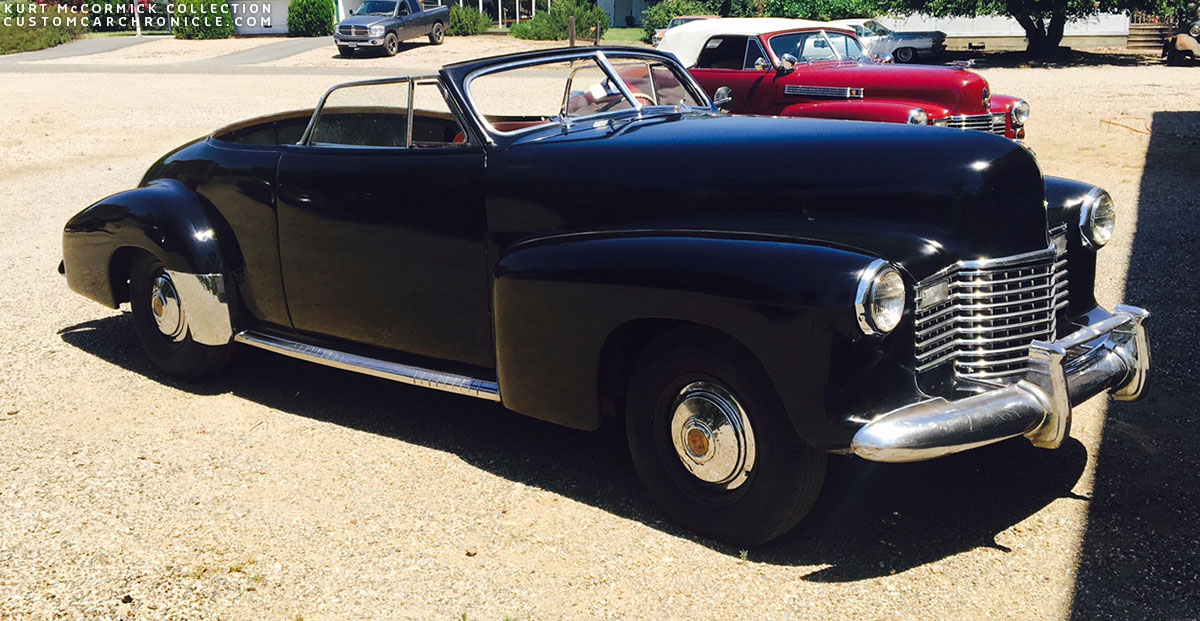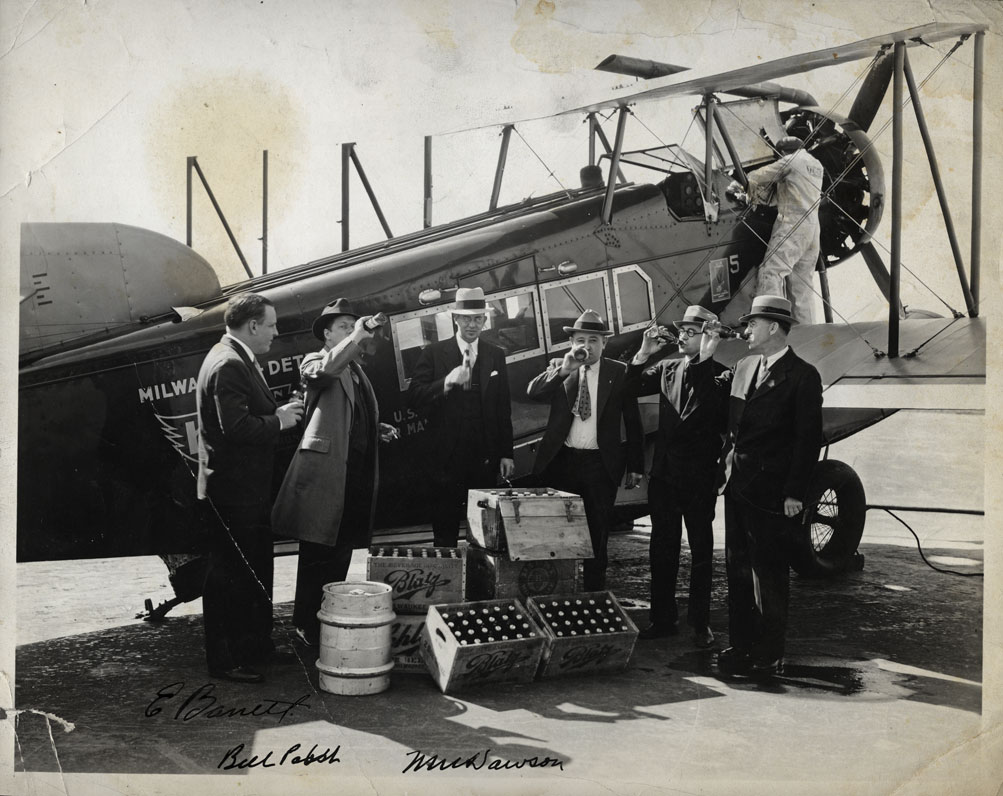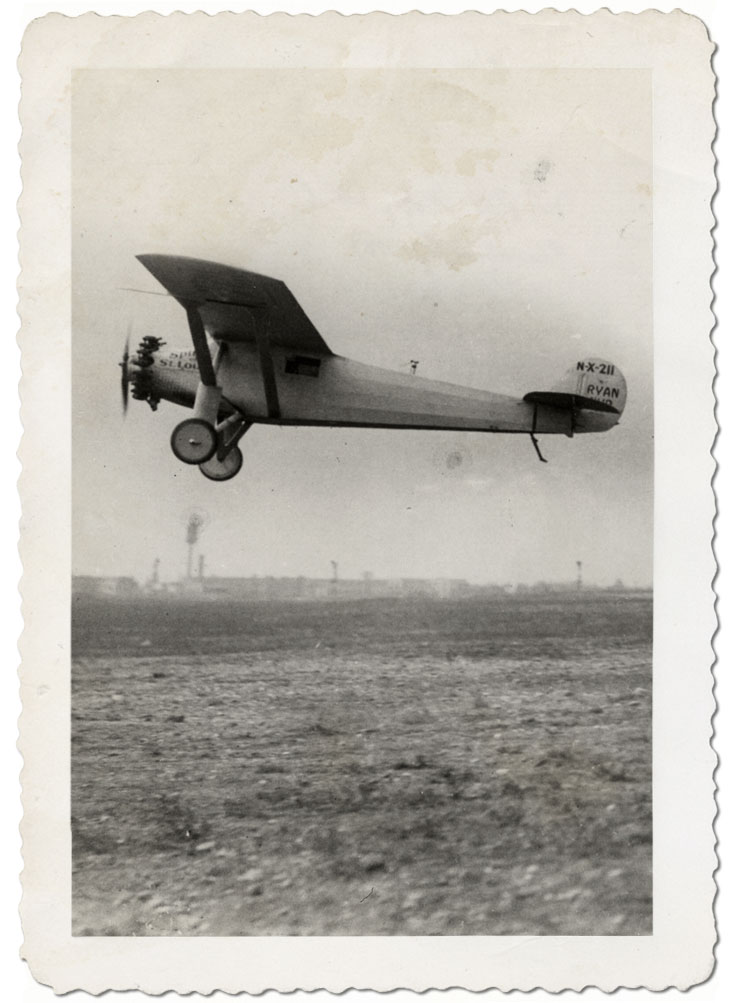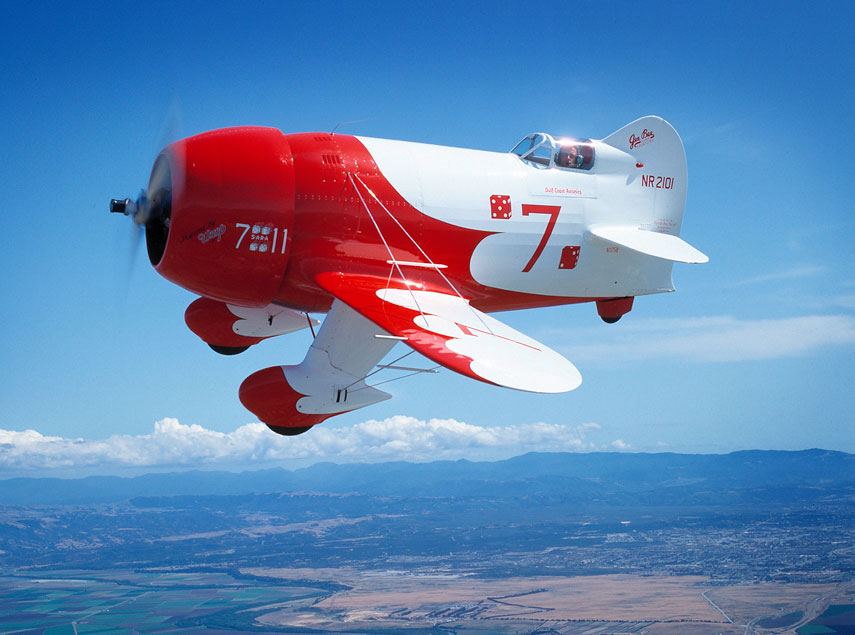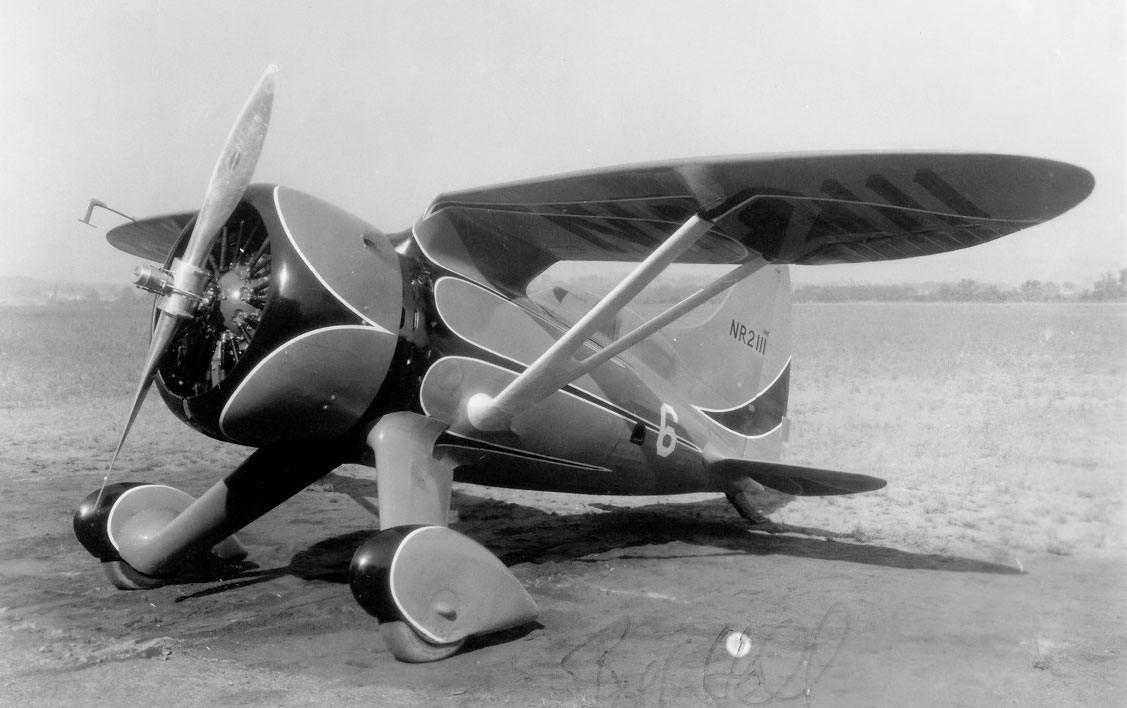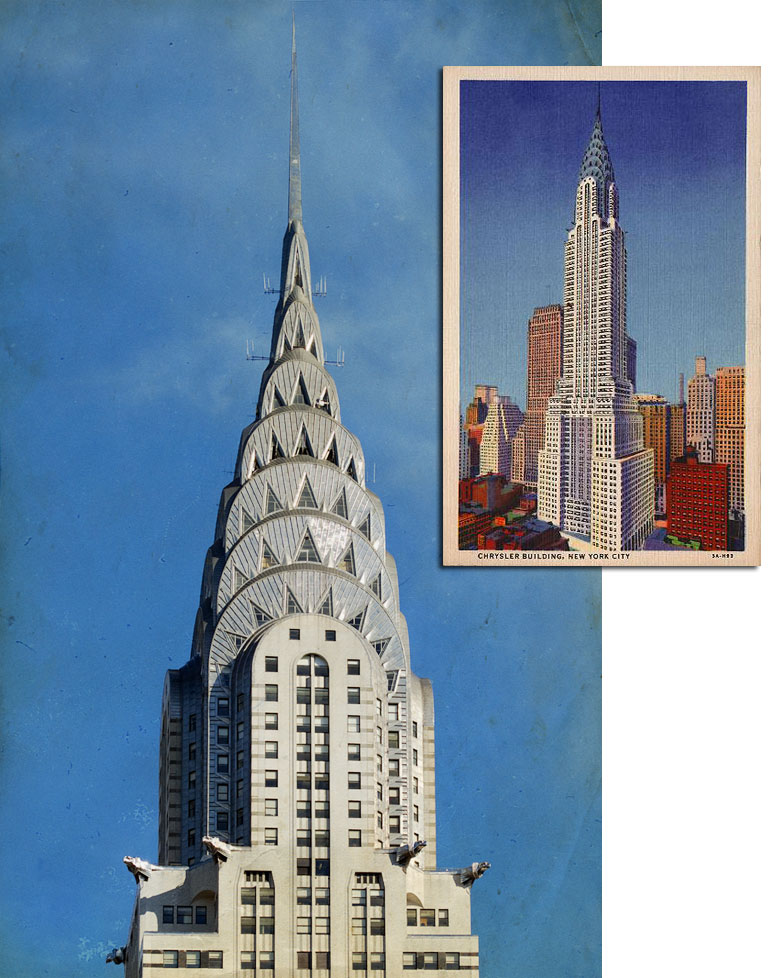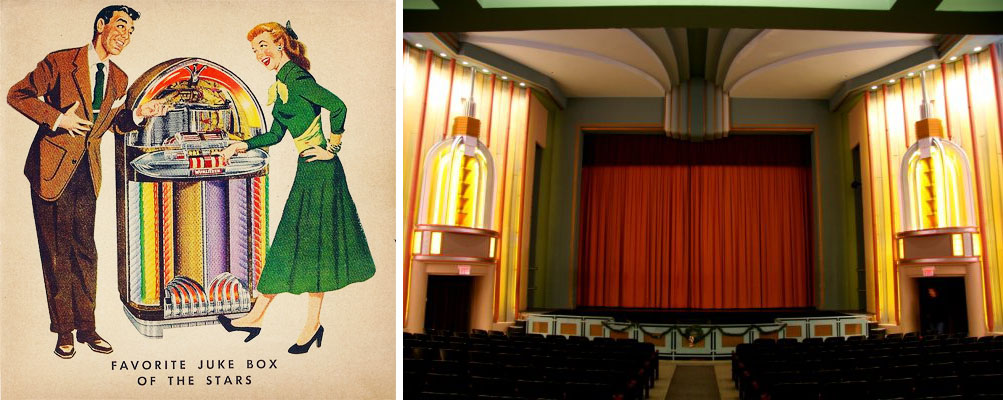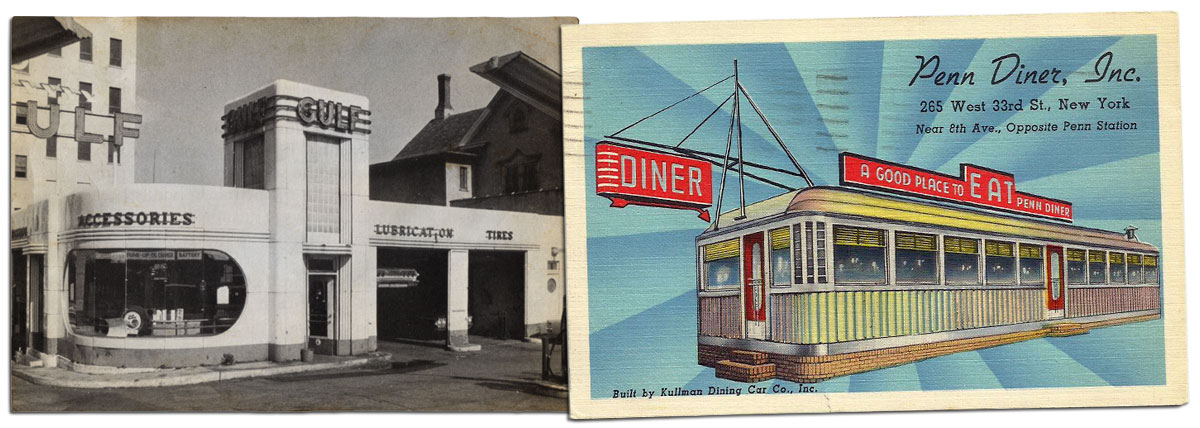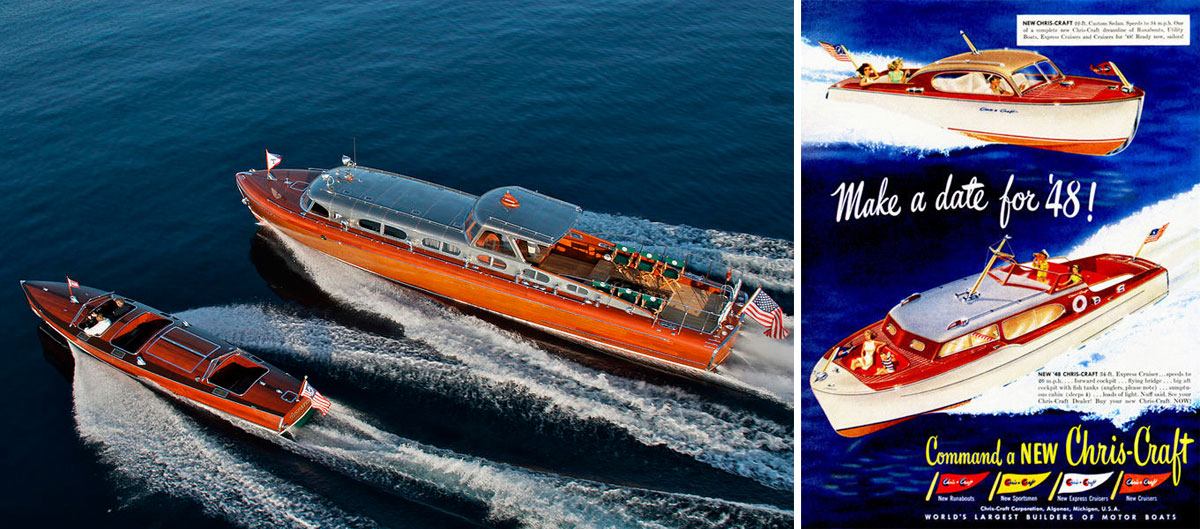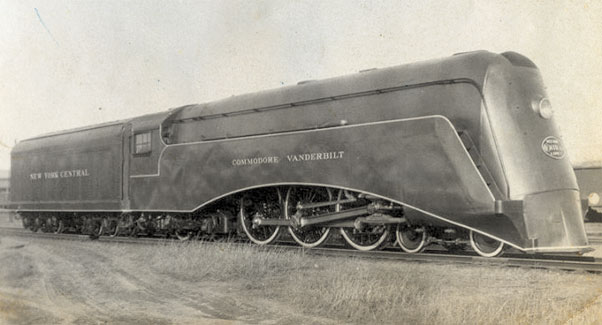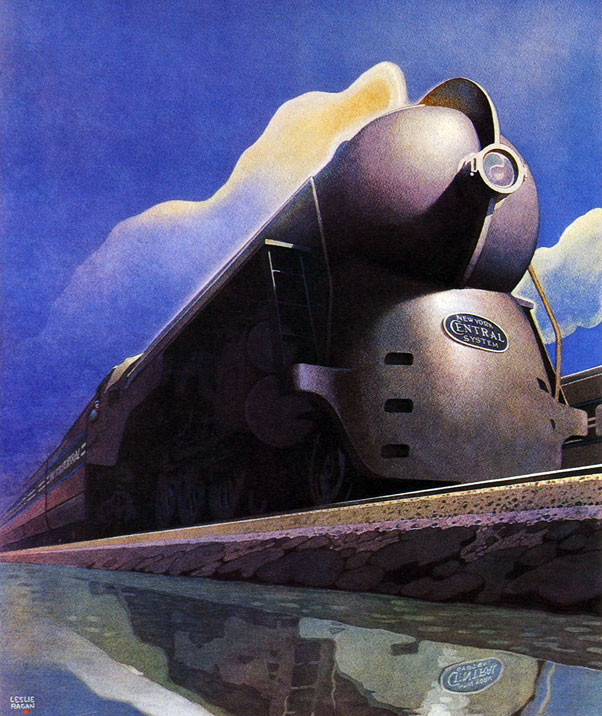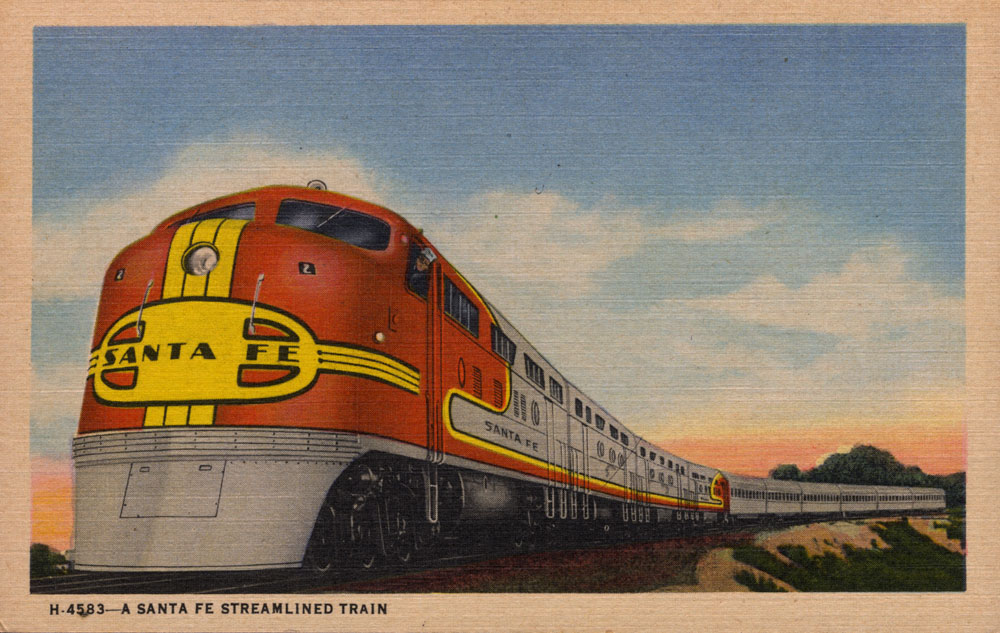CHOP TOP HISTORY part 1
The most transforming of all custom body changes, if not the most beautiful, is lowering of the top. Better known as the Chopped Top.
One of the best known, perhaps most desirable Custom techniques of them all is chopping a top. For this CCC-Article I will concentrate on the history of chopping metal-tops from coupe or sedan models of cars typically used for customizing 1933 and up. It is generally accepted that chopping the windshields of convertibles and roadster style bodies – with or without a matching padded top – was done earlier than chopping the metal topped coupes and sedan’s. The reason the convertible tops were done earlier is obviously, the relative easy modification of removing a few inches from a straight window pillar compared to removing a few inches from a cone shaped top of a coupe of sedan. But who was the first to tackle the coupe or sedan chop, when and where was it done first on a custom. In this first part we will concentrate on the early beginnings of chopping tops, done mostly on cars from the 1930’s up to 1940, restyled in the period till around 1950.
Influences
I think it is fair to say that we most likely will never find out who actually chopped the first top on a custom. Customs as we see them are based on the 1933 and up cars. And as far as I have found out it took a few years before the first body guy started to experiment with lowering the top on one of these cars. So far the first chopped metal top custom I have been able to find was a 1937 Ford sedan that had a lowered and reshaped top to be a mix between a sedan and coupe. The top portion of the roof was covered with canvas making it looks a bit like a padded top custom, but it was in fact an all metal top. We do not have an exact date when this car was build, but from the things we have found it looks to have been done 1-2 years after it came from the factory. Sadly in those years not many photos were taken. The work done on the early customs was not considered to be very special, worth documenting, or even remembering. Still it is interesting to see how much we can find out, how far we can go back. And perhaps, or hopefully some of our readers will remember more and will fill in some gaps, and add details to the story.
![CCC-early-custom-37-ford-sedan-a-drake]() One of the earliest cars with a chopped top we have been able to find was an 1937 Ford sedan with a cut down and vinyl wrapped top. We are not 100% sure when this car was chopped, but it was most likely in either 1937 or ’38. More photos of this car can be seen HERE.
One of the earliest cars with a chopped top we have been able to find was an 1937 Ford sedan with a cut down and vinyl wrapped top. We are not 100% sure when this car was chopped, but it was most likely in either 1937 or ’38. More photos of this car can be seen HERE.
Coach-building and design studies
There are several direction we can look at that inspired the early custom car builders to start chop the top on cars. One of the directions is the design sketches from designers from the 1930’s. Both independent as well as those working for the big car companies. The design sketches made to find directions the next model was hinting to were often drawn with low stance, long wheel-base, and small size windows with low tops. This way the car looks more sinister, longer, more powerful, faster, and above all more attractive. When the designs were approved the design was mostly adapted to the real life situation and more than often the request was to create an automobile in which the owner could keep his hat on, demanding a tall top. The beautiful design sketches however did have its influence, and the designs on them were often combined with the real life cars for the sales ads, and brochures, to make the cars look more attractive.
![CCC-chopped-top-history-art-ross-designs]() Art Ross created many design sketches for the Duesenberg and other high end automobiles in the mid 1930’s. Many of his sketches show car bodies, coupes and sedans with vary small side windows and raked back windshields giving the designs a what we now would name a chopped look. Many other designers came up with similar chopped top designs in the mid to late 1930’s.
Art Ross created many design sketches for the Duesenberg and other high end automobiles in the mid 1930’s. Many of his sketches show car bodies, coupes and sedans with vary small side windows and raked back windshields giving the designs a what we now would name a chopped look. Many other designers came up with similar chopped top designs in the mid to late 1930’s.
Cars that did not have to meet public standards were Coach-build cars. These however were mostly based on high end cars, like Duesenberg, Packards and Cadillacs. When these cars were special ordered by the mostly rich clients, the finished looks were often more important that the practical effect of the cars. Designers working with the Coach builders could create new more streamlined roof tops, much lower and more atractive than the production stylist from the bigger car companies. The Coach-builders only had to please one client. In was in the early/mid 1930’s that these coach-builders started to come up with cars with smaller windows, leaned back windshields and more streamlined rear portions of the roof.
Since the car bodies were mostly build from scratch we cannot really call these chopped cars, but they sure had the looks of what we later would call chopped cars. These low roofed streamlined cars looks so wonderful, and must have influenced many young car enthusiast in the mid to late 1930’s. Most of this coachbuilding happened in sunny California where the people were more car loving than in other parts of the US at the time. One of the reasons was of course the great all year round weather, but also the great new roads that did not suffer from strong winters causing many holes and bad surfaces. However the year-round decent weather in California did not make the choice of a coupe or sedan to be your next Coach-build or Custom a logic step. Perhaps financial reason might have played a roll in choosing a sedan or coupe, which were cheaper than the more desirable convertible and roadsters.
![CCC-chopped-top-history-b-s-32-duesenburg]() This Duesenberg was originally built in 1932 as a short-wheelbase four-door sedan. The owner Dr. Seeley Mudd sent the car to Bohman & Schwartz for a complete new body. it was finished with the new chopped looking top inn 1937. The design of the car employed aerodynamic principles that were only experimental in the 1930s. Body panels were covered with leather-like Zapon cloth.
This Duesenberg was originally built in 1932 as a short-wheelbase four-door sedan. The owner Dr. Seeley Mudd sent the car to Bohman & Schwartz for a complete new body. it was finished with the new chopped looking top inn 1937. The design of the car employed aerodynamic principles that were only experimental in the 1930s. Body panels were covered with leather-like Zapon cloth.
![CCC-chopped-top-history-LeBaron-Lincoln]() This is what LeBaron came up with in 1937 when they did coachwork on a Lincoln Model K chassis. It looks very much like an oversized chopped 1935 – 36 Ford 3w coupe. (thanks Per Webb)
This is what LeBaron came up with in 1937 when they did coachwork on a Lincoln Model K chassis. It looks very much like an oversized chopped 1935 – 36 Ford 3w coupe. (thanks Per Webb)
![CCC-chopped-top-history-phantom-corsair]() Bohman & Schwartz also created the Phantom Corsair. This very streamlined car finished in 1937 had a wonderful chopped like roof and small windows.
Bohman & Schwartz also created the Phantom Corsair. This very streamlined car finished in 1937 had a wonderful chopped like roof and small windows.
Sales Illustrations
Another influence for the first chopped tops on customs most likely were the sales ads and car brochures created for the mid/late 1930’s cars. In this period, up to the late 1940’s (and even later) most of the car magazine ads and sales brochures used illustration of the cars rather than actual photos. One of the reasons to do this was that it was easier to slightly alter the cars in the illustrations to make them look longer, lower, more attractive than in a photo. Today all this is done in Photoshop, but back then creating an better than real life illustration was the way to go. Many of the illustrations used back then show cars with a much lower top than the actual production car. The low top gives the car a much longer, and lower appearance, which makes the car look more attractive than when the illustrator showed the actual height of the top. Most likely this lower look must have influenced the young car-builders from the late 1930’s early 1940’s in experimenting with the cut down tops.
![CCC-chopped-top-history-car-ads-01]() This sample shows an ad for the 1935 Ford coupe and the 1936 Ford sedan. Both image illustrations show the cars with a much lower top than the actual production car. The low top give the car a much longer, and lower appearance, which makes the car look more attractive in these sales ads than when the illustrator had used the actual height of the top.
This sample shows an ad for the 1935 Ford coupe and the 1936 Ford sedan. Both image illustrations show the cars with a much lower top than the actual production car. The low top give the car a much longer, and lower appearance, which makes the car look more attractive in these sales ads than when the illustrator had used the actual height of the top.
Padded topped convertibles
The Carson Top Shop created the padded Frensh top design in 1935, and around 1937 the first chopped padded top was produced by the Carson top shop. We will come back on the chopped padded top in a separate article at a later time. As mentioned before lowering a convertible top was a lot easier than to lower an all metal top. But the looks of these lowered padded toped customs might have inspired the first person to lower the top on the metal top cars.
![Carson Top Shop]()
Dry lake racing
In the early 1930’s there were a lot of young guys who took their model A’s to the California dry lakes to go racing on the immense lake beds that turned out to be absolutely perfect to go fast, and faster. Some of the cars racing there had cut down windshields to reduce air flow and make the cars faster. Some of these cars even had their convertible tops cut accordingly creating a nice low profile. The lowered windshields gave these cars a whole different, more tougher, longer, powerful look. This looks most likely helped some of the customizers later on when they started to think about lowering the top on their metal top coupes and sedans. Perhaps at first to use them on the dry lakes to increase speed, and later for the looks.
![CCC-chopped-top-history-35-ford-ed-hagthrop]() Ed Hagthrop’s chopped 1935 Ford Coupe at one of the mid 1940’s dry lake events.
Ed Hagthrop’s chopped 1935 Ford Coupe at one of the mid 1940’s dry lake events.
About chopping tops in early publications
The earliest publications I have been able to find listing the lowering of the top on Custom Cars technique dates back to 1944. Dan Post published a series of typed “Mimeographs” in the 1940’s names Remodeler’s Manual for Restyling your car Informal Notes and Observations of Body Alterations to Bring Your Auto Lasting Style. The first one of these was published in 1944. The technique was however not named Chopped Top yet, at least not in the publications. It was named Lowering Hard Tops, meaning metal tops in contrast to lowering convertible tops. The first time the technique was named Chopping Tops was published in 1949 as far as I have been able to find it. Edgar Almquist also produced a series of Custom Styling Manuals, and the first one he did in 1946 has a nice write up on the technique as well. As far as I have been able to find out the name Chopping Tops has been used since around 1946, perhaps even earlier, but the first time it can bee seen used is on the early photos of the Barris Compton Avenue shop from around 1946.
![CCC-chopped-top-history-dan-post-1945-01]() The first time chopping the top on customs was described in a publication was, as far as I have found out, the Dan Post Remodeler’s Manual for Restyling your Car first published in 1944. The above sample comes from the 1945 version of this manual which had a few minor corrections added. The technique was not yet listed as “chopping”.
The first time chopping the top on customs was described in a publication was, as far as I have found out, the Dan Post Remodeler’s Manual for Restyling your Car first published in 1944. The above sample comes from the 1945 version of this manual which had a few minor corrections added. The technique was not yet listed as “chopping”.
![CCC-chopped-top-history-Almquist-1946-01]() Edgar Almquist published a series of Custom Styling Manual’s in the 1940’s. In the 1946 edition of this Manual he described the Lowering Metal Tops technique. The picture 9 mentioned in the text showed a Barris build 1941 Chevy coupe with filled in rear quarter windows. We will discuss this car in part two of this series.
Edgar Almquist published a series of Custom Styling Manual’s in the 1940’s. In the 1946 edition of this Manual he described the Lowering Metal Tops technique. The picture 9 mentioned in the text showed a Barris build 1941 Chevy coupe with filled in rear quarter windows. We will discuss this car in part two of this series.
![CCC-chopped-top-history-dan-post-1947-03]() This written description of cutting down the top comes from the 1947 Dan Post “Master Custom-Restyling Manual”. The “Photo 10 mentioned in the text is shown below.
This written description of cutting down the top comes from the 1947 Dan Post “Master Custom-Restyling Manual”. The “Photo 10 mentioned in the text is shown below.
![CCC-chopped-top-history-dan-post-1947-01]() Photo 10 in the Dan Post “Master Custom-Restyling Manual” shows a 1934 Ford Vicky with chopped top, an unknown Mopar sedan in the back and an unknown 1939-40 Mercury coupe with chopped top very vague in the foreground. It appears that the Mercury coupe in the foreground has the windshield raked back, a different technique than listed in the text.
Photo 10 in the Dan Post “Master Custom-Restyling Manual” shows a 1934 Ford Vicky with chopped top, an unknown Mopar sedan in the back and an unknown 1939-40 Mercury coupe with chopped top very vague in the foreground. It appears that the Mercury coupe in the foreground has the windshield raked back, a different technique than listed in the text.
![CCC-chopped-top-history-dan-post-illustration]() The Dan Post “Blue book of Custom Restyling from 1949 shows this illustration guiding the reader how to cut the top on a “hard-top” coupe. This is the first time I have found that the technique was named CHOPPED in a publication.
The Dan Post “Blue book of Custom Restyling from 1949 shows this illustration guiding the reader how to cut the top on a “hard-top” coupe. This is the first time I have found that the technique was named CHOPPED in a publication.
![CCC-chopped-top-history-george-barris-1950]() George Barris was interviewed for the April 1950 issue of Motor Trend magazine about Custom Restyling. This is what he said about chopping tops.
George Barris was interviewed for the April 1950 issue of Motor Trend magazine about Custom Restyling. This is what he said about chopping tops.
![CCC-chopped-top-history-barris-40-ford-chop-01]() A photo of a heavy top chop in progress on a Barris created 1940 Ford coupe was used to illustrate the Chopped Top technique in the April 1950 issue of Motor Trend magazine. The car in the photo has the windshield angled back a lot and looks to be far from finished in the back.
A photo of a heavy top chop in progress on a Barris created 1940 Ford coupe was used to illustrate the Chopped Top technique in the April 1950 issue of Motor Trend magazine. The car in the photo has the windshield angled back a lot and looks to be far from finished in the back.
![CCC-chopped-top-history-custom-car-an-1951]() In 1951 Motor Trend magazine produced the first of the Custom Cars Annuals. Trend book No. 101. To describe chopping the top technique they used the George Barris text from the Motor Trend April 1950 issue, with more explaining added to it.
In 1951 Motor Trend magazine produced the first of the Custom Cars Annuals. Trend book No. 101. To describe chopping the top technique they used the George Barris text from the Motor Trend April 1950 issue, with more explaining added to it.
![CCC-chopped-top-history-dan-post-collage]() This photo collage of customs appeared for the first time in the Dan Post Blue Book of Custom Restyling published in 1949. Most of the photos had already been used in his publications from 1947. It shows how few metal topped cars were actually chopped, compared to the convertible chopped and non-chopped cars.
This photo collage of customs appeared for the first time in the Dan Post Blue Book of Custom Restyling published in 1949. Most of the photos had already been used in his publications from 1947. It shows how few metal topped cars were actually chopped, compared to the convertible chopped and non-chopped cars.
One of the things I have noticed in my research on the chopped top subject is that in general the chops on the early customs is less radical than those done in later years, more towards the end of the 1940’e and early-mid 1950’s. The main reason for this I believe is because of balance. From the early beginning of customizing, at least customizing with the reason to improve the looks of an automobile, there has been the realization that the customizing needs to be done in balance with the rest of the car. There is a balance between the amount of chop and stance of the car. Early customs usually had a higher stance, so the top was lowered proportional. Later in the 1940′ the cars were often more lowered, which could be done because the roads got better. Therefor to stay in balance with the side view of the car the top needed to be chopped a bit more than before. Of course there are always exceptions to these rules. But over all the chop amount on the early customs was a bit less than later on.
Another thing that I noticed is that in most cases the cars that have been chopped have remained the drip rails. In some cases the drip rails were shortened and ended just after the door openings. But they were rarely completely shaped as we are so familiar with from the late 1940’s early 1950s. Another thing that I have noticed is that the early chops appear to be a bit more boxy, less streamlined than how they were done in the later part of the 1940’s and early 1950’s.
The 1936 Fords
From all the photos of the early chopped custom cars I have come across it looks like the first chopped metal topped body must have been a 1936 Ford. There are early samples of the 5-window coupes as well as the two door sedan bodies as chopped customs. It looks like, and I’m not sure why this is, that the now more popular 3-window coupe was not amongst the first body styled that were cut.
Santa Monica ’36 Ford 5-window Coupe
The earliest chopped Custom Car I have been able to find that can be dated with a license plate is an beautiful restyled 1936 Ford 5-window coupe build in the late 1930. I know of two photos of this car, and both show the car with 1940 California license plates. According Dean Bachelor who took one of these photos of this car has mentioned in the past that the car had been restyled by the Santa Monica Body Works company. We have not been able to find out anything about this shop, but most likely it was a regular body shop and the owner of the Ford might have requested the shop to perform the custom body work. A common practice on early customs. The car has the top lowered a few inches, well balanced with the stance of the car, not to much, just perfect.
![CCC-36-ford-5-window-1941-02]() Santa Monica Body works restyled this 1936 Ford 5-window coupe in late 1930’s or early 1940 with a chopped top, removed running boards, smooth hood sides, narrowed grille and separate grilles in the front fenders. One of the most beautiful ’36 ever done.
Santa Monica Body works restyled this 1936 Ford 5-window coupe in late 1930’s or early 1940 with a chopped top, removed running boards, smooth hood sides, narrowed grille and separate grilles in the front fenders. One of the most beautiful ’36 ever done.
![CCC-36-ford-sedan-mark-murray-00]() Mark Murray shared this photo of a 1936 Ford Sedan from his grandfathers photo albums. Mark always heard his grandfather say that this one might have been the first 1936 Ford sedan to be chopped. This side profile shows how much the top was chopped.Sadly we cannot see a license plate or date on the photo to help us identify it. It does look to have been done in either the late 1930’s or early 1940’s.
Mark Murray shared this photo of a 1936 Ford Sedan from his grandfathers photo albums. Mark always heard his grandfather say that this one might have been the first 1936 Ford sedan to be chopped. This side profile shows how much the top was chopped.Sadly we cannot see a license plate or date on the photo to help us identify it. It does look to have been done in either the late 1930’s or early 1940’s.
![CCC-chopped-top-history-murray-chop-progress]() Mark Murray also shared these two photos of an 1936 Ford coupe getting chopped. Pretty rare photos, since there are not to many early photos of these cars getting worked on. These two photos were taken around 1948.
Mark Murray also shared these two photos of an 1936 Ford coupe getting chopped. Pretty rare photos, since there are not to many early photos of these cars getting worked on. These two photos were taken around 1948.
Tommy Jamieson ’36 Ford 5-window Coupe
Howard Fall restyled this 1936 Ford 5-window coupe (below) for Tommy Jamieson in 1939-1940. The car is much more radical than most of the custom from this period. The body has been channeled over the frame and 1937 Ford front fenders raised so that the bottom edge would be level with the lower parts of the main body. The hood was replaced with an modified 1938 Ford hood, top chopped with vertical pillars and rather upright rear of the top. Custom made grille and sollid hood sides. The rear fenders are stock and use 1938 Ford teardrop taillights, the license plate is set in in the rear valance and the bumpers are replaced by 1940 Mercury units. Howard Fall painted the car two-tone green.
![CCC-chopped-top-history-tommy-jamiesson-01]() Tommy Jamieson heavily restyled 1936 Ford 5-window coupe with chopped top in 1941.
Tommy Jamieson heavily restyled 1936 Ford 5-window coupe with chopped top in 1941.
![CCC-chopped-top-history-tommy-jamiesson-02]() Tommy’s ’36 Ford is an unique custom with a lot of restyling going on, especially for the time it was created. Notice how upright the rear of the top is. This was done before the streamlined style would be favored.
Tommy’s ’36 Ford is an unique custom with a lot of restyling going on, especially for the time it was created. Notice how upright the rear of the top is. This was done before the streamlined style would be favored.
Bob Fairman / Jimmy Summers ’36 Ford coupe
Bob’s ’36 Ford 3-window coupes with the full fade away fenders is one of the first chopped coupes I have been able to locate. Together with George Barris his ’36 Ford 3-window they both appear to have been build in 1941. We are not sure if it was Jimmy Summers who chopped the top on Bob’s Ford, or if he perhaps did it himself or together with Jimmy while he worked in his shop. The chop on Bob’s coupe was a relatively mild chop, especially if you compare it with some of the others like George Barris or Bob Pierson’s coupes.
![CCC-fadeaway-fenders-summers-03]() Bob Fairman’s 1936 Ford chopped 3-window coupe with full fade away fenders was created when Bob worked for Jimmy Summers. The earliest plates we have seen on this car are from 1941.
Bob Fairman’s 1936 Ford chopped 3-window coupe with full fade away fenders was created when Bob worked for Jimmy Summers. The earliest plates we have seen on this car are from 1941.
![CCC-chopped-top-history-36-ford-filled-window]() Even thought these photos were taken in 1949, the car in the photos very much appears to have been restyled in the early 1940’s. The chopped top is rather square, with is further enhanced by the filled in rear quarter windows. From what I can see no part on the car is newer than 1941.
Even thought these photos were taken in 1949, the car in the photos very much appears to have been restyled in the early 1940’s. The chopped top is rather square, with is further enhanced by the filled in rear quarter windows. From what I can see no part on the car is newer than 1941.
George Barris ’36 Ford Coupe
The first real full custom George Barris created for himself was a 1936 Ford Coupe in 1941. It shows a typical Nor Cal style we often associate with as the Harry Westergard Style. Long, sleek, high small nose and a speed boat stance. However I do not think we have ever seen a early chopped coupe of sedan done by Harry Westergard. George chopped the top on his personal ’36 Ford a few inches, nothing really radical, but from the photos we do have of the car it looks to be very well balance. with the highpoint in the center of the door.
![CCC-george-barris-36-ford-coupe-02]()
Jack Calori Ford
One of the most influential chopped ’36 Ford’s ever is the the chopped coupe Herb Reneau created for his friend Jack Calori. It is another car done in the typical Harry Westergard style, but on this car we are not even sure if the owner, or builder have actually ever been in contact with Harry, nor any of the customs he has created. The Calori Coupe did however have a huge impact, and one of the reasons was because it was featured on the cover of the November 1949 issue if the Hot Rod magazine. A very popular magazine at the time. Inside the car had a massive three pages including an incredible x-ray drawing by Rex Burnett. The one thing a bit odd for a custom around this time were the black wall tires, but that was how Jack liked it, he was a Hot Rodder, not so much a Custom Car guy. The car was restyled in Long Beach California in 1948 by body man and good friend of Jack Calori Herb Reneau. As far as we know this was Herb’s first chopped top on n all metal top. Most likely the picture in this issue of Hot Rod magazine has inspired many young guy to start working on a chopped 36 Ford Custom all over the US.
![CCC-chopped-top-history-calori-1949-01]()
![CCC-chopped-top-history-calori-1949-02]() The set free photos and the X-Ray drawing show the real beauty of the car very well and how much impact the chopped top has on the ’36 Ford coupes.
The set free photos and the X-Ray drawing show the real beauty of the car very well and how much impact the chopped top has on the ’36 Ford coupes.
Bob Pierson ’36 Ford Coupe
Another very famous 1936 chopped Ford Coupe was the one owned by Bob Pierson. The car was originally build as a mildly restyled street custom in 1947 But in 1949 it was decided to chop the top to enter it in a different category at the dry lake races. However the car was not only build to race, everything was made to look really good as well. Bob and Dick Pierson and Harry Jones chopped the top on the car. Harry was a body man from Inglewood who also painted their 2D coupe. The chopped top coupe was well traveled in SoCal in the late 1940’s early 1950’s.
![CCC-chopped-top-history-pierson-bros-36-ford-01]() Bob Pierson’s 1936 Ford how it was originally restyled in ’47. DeSoto bumpers, Appleton spots, a bull-nose, ripple disc hubcaps, and solid hood sides and teardrop skirts. (This photo was given to the current, 2016, owner of the car by Dick Pierson.)
Bob Pierson’s 1936 Ford how it was originally restyled in ’47. DeSoto bumpers, Appleton spots, a bull-nose, ripple disc hubcaps, and solid hood sides and teardrop skirts. (This photo was given to the current, 2016, owner of the car by Dick Pierson.)
![CCC-chopped-top-history-pierson-bros-36-ford-02]() By 1949 Bob drove the car around with a wonderful chopped top. (photo from the Bob Pierson’s personal scrapbook)
By 1949 Bob drove the car around with a wonderful chopped top. (photo from the Bob Pierson’s personal scrapbook)
![CCC-chopped-top-history-michican-36-ford-02]() We do not know when this photo was taken, most likely in the early to mid 1940’s. It shows a rather badly chopped ’36 Ford 5-window coupe with the rear quarter windows and roof top filled in from Michigan. The engine was replaced by a Cadillac flathead engine1
We do not know when this photo was taken, most likely in the early to mid 1940’s. It shows a rather badly chopped ’36 Ford 5-window coupe with the rear quarter windows and roof top filled in from Michigan. The engine was replaced by a Cadillac flathead engine1
Other early chopped customs
The 1936 Fords might have been the first coupes and sedans from which the tops were cut and lowered. But they sure were not the only ones. In the early years the FoMoCo cars however were dominating the custom scene. But from early one all year models ended up with chopped tops. Some model years turned out to be more popular than others. The 1939 and 40 Mercury coupes have been very popular candidates for the chopped top from around them mid 1940’s. The almost hard-topped looking top was extremely high on the coupes, making it look very odd, and a prime candidate for a haircut.
We have noticed that quite a few of the early chopped cars had kept the drip-rails in place. In some cases the drip rails were shortened, especially on the cars that had the rear quarter windows closed, which was another popular custom style in the early years. Most likely the closing of the rear quarter windows was inspired by the padded tops created for the chopped convertibles.
![CCC-barris-dick-fowler-38-ford-01]() Dick Fowler’s 1938 Ford Coupe was another early chop done at the Barris Shop. The shop was done most likely around 1946. The amount removed from the top was more than on most in this period. The car was also lowered a little more than other. And Barris shaved the drip rails on this one for an ultimate smooth look.
Dick Fowler’s 1938 Ford Coupe was another early chop done at the Barris Shop. The shop was done most likely around 1946. The amount removed from the top was more than on most in this period. The car was also lowered a little more than other. And Barris shaved the drip rails on this one for an ultimate smooth look.
Earl Bruce 1940 Ford Coupe
Earl Bruce bought his 1940 Ford DeLuxe business coupe on September 15, 1939 at Al Stuebing Ford on Cahuenga Blvd in L.A. According the story in American Rodder magazine he drove it straight from the dealer to the northwet corner of Melrose Avenue and Fairfax where Jimmy Summers had his shop. He ordered a full chop and filled quarter windows from Jimmy. There are also stories that Roy Hagy chopped the top on Earl’s Coupe for first owner Tommy Winship, not sure which story is right. The fact is that the car was chopped in late 1939 and the first images we have found of it are from October 4th 1940 when the car was filmed at an scta event.
![CCC-chopped-top-history-earl-bruce-01]() Movie clips from the October 4th 1940 SCTA event show the Earl Bruce 1940 Ford with the fresh chopped top and fog lights used as taillights. Notice that Bruce used a set of 1939 Ford headlights on the car early on.
Movie clips from the October 4th 1940 SCTA event show the Earl Bruce 1940 Ford with the fresh chopped top and fog lights used as taillights. Notice that Bruce used a set of 1939 Ford headlights on the car early on.
![CCC-chopped-top-history-earl-bruce-02]() These two photos were take a little later in the 1940’s. It shows that the car was now outfitted with rear fender mounted Buick taillights. The headlights are now replaced with 1940 Ford units. Notice how small and high located the rear window is.
These two photos were take a little later in the 1940’s. It shows that the car was now outfitted with rear fender mounted Buick taillights. The headlights are now replaced with 1940 Ford units. Notice how small and high located the rear window is.
![CCC-chopped-top-history-earl-bruce-03]() This side view taken a little later, gives us a good look at this early chopped coupe top. The whole top has taken on a quite different shape than the stock top, and appears to have been stretched in the center. The rear quarter windows are filled in and the door top corners have been rounded. The drip rail was shortened to a few inches behind the door.
This side view taken a little later, gives us a good look at this early chopped coupe top. The whole top has taken on a quite different shape than the stock top, and appears to have been stretched in the center. The rear quarter windows are filled in and the door top corners have been rounded. The drip rail was shortened to a few inches behind the door.
Another early chopped coupe styled in a similar way as the Earl Bruce coupe was the Bob Creasman 1940 Ford coupe. Bob’s coupe was chopped in 1943 by Bob Creasman and the Brand Brothers Body Shop in Los Angeles. Four inches were removed from the top. The top was extend four inches to make sure the A-pillars and the rear of the top would line up after the top was lowered. The rear quarter windows were filled in, just as on Earl Bruce his coupe. Later in the 1940’s the car was outfitted with a set of full fade away fenders.
John Williams ’40 Ford Coupe
The Olive Hill Garage on Sunset and Vermond in Hollywood, which was run by Art Lellis and Jerry Moffatt created some very fine restyled customs in the early years. One of those cars was John Williams 1940 Ford coupe that was chopped in either late 1939, or early 1940. The car was done really beautifull with some very nice well designed restyling including peaked hood, Lincoln bumpers, smoother body and a very good looking chopped top. Two photos of the car appeared in the first Custom Car annual from 1951, and show the chopped and finished car with 1940 California license plates. One other photo was used on the February 1949 issue of Hot Rod Magazine. Unlike several others John’s coupe was chopped with the rear quarter windows still in place.
![CCC-chopped-top-history-john-williams-art-jerry-01]()
![CCC-chopped-top-history-40-ford-coupe-01]() Unidentified 1940 Ford chopped Coupe from the Bart Bartoni collection (Don Montgomery books) is very interesting. The car appears to be mostly stock, except for 1946-48 Ford bumpers, a bit lower suspension, and a wonderful proportioned chop. It looks like it just rolled out of an 1940’s magazine ad illustration.
Unidentified 1940 Ford chopped Coupe from the Bart Bartoni collection (Don Montgomery books) is very interesting. The car appears to be mostly stock, except for 1946-48 Ford bumpers, a bit lower suspension, and a wonderful proportioned chop. It looks like it just rolled out of an 1940’s magazine ad illustration.
Don Lee ’40 LaSalle
Don Lee created a few restyled cars for his clients. They do not really fit the Custom theme we discuss here per-see, but I feel they need to be mentioned here anyway. These were also done very early. The 1940 LaSalle shown here was done in 1940, and shows how the windshield remained stock height, but leaned back to create a lower roof prifile. The rear quarter windows had been filled in and the whole top smoothed. Don Lee also created a similar styled Cadillac based on a 1941 Cadillac Series 62 Coupe for Clark Gable and Carole Lombard.
![CCC-chopped-top-history-don-lee-40-lasalle]() Don Lee’s 1940 LaSalle Coupe with chopped top and leaned back windshield. Chrome rock shields and teardrop shaped skirts. Created in 1940.
Don Lee’s 1940 LaSalle Coupe with chopped top and leaned back windshield. Chrome rock shields and teardrop shaped skirts. Created in 1940.
Chopped sedans
The majority of the early chopped metal top cars were based on coupes, or coupe turned cars. The coupes and convertible body style was always a more preferable style, if you could afford it. These styles were a bit more expensive than the family 2- and 4-door sedans. Overall the coupes and convertible had better lines, longer doors and a wonderful flowing top design, making them the number one choice for customizers as well. But there were also a number of good looking custom sedans. I’m not sure if these cars were based on sedans because the owner wanted it specifically to be a sedan, or if that was all the budget allowed at the time. Either way, quite a few sedans were chopped in the golden years of customizing, and with great success.
There are a great number of samples of chopped sedans that have really great improved lines and have become stunning looking customs. And the plus of course is a lot of space inside, a comfortable ride for four or more. Chopping a custom sedan was most of the time a bit harder to do that a coupe. Especially if the rear of the body was slanted forward. Then often the whole rear of the car needed to be reshaped to flow with the new roof shape. But the end result, when performed right, looked stunning.
![CCC-chopped-top-history-38-ford-sedan-barris]() Barris Customs restyled this 1938 Ford Standard sedan with a heavy, beautiful flowing chop, smooth hood sides and Packard Clipper grille. The rear of the body had to be reshaped, angled forward to make it flow with the new roof shape. The work was done in 1946-47. These photos appeared in a 1947 published Dan Post booklet.
Barris Customs restyled this 1938 Ford Standard sedan with a heavy, beautiful flowing chop, smooth hood sides and Packard Clipper grille. The rear of the body had to be reshaped, angled forward to make it flow with the new roof shape. The work was done in 1946-47. These photos appeared in a 1947 published Dan Post booklet.
![CCC-39-40-fomoco-sedan-customs-02]() This great photo from the Bart Bartoni Collection (courtesy of the Don Montgomery books) shows a 1939 Ford 2-door sedan in the mid 1940’s. Wonderful early style custom with a heavy chop. The chop on this one appears to be a bit more “boxy” than the 38 Ford above. Most likely indicating that the roof on this one was actually lengthened with an added “band”.
This great photo from the Bart Bartoni Collection (courtesy of the Don Montgomery books) shows a 1939 Ford 2-door sedan in the mid 1940’s. Wonderful early style custom with a heavy chop. The chop on this one appears to be a bit more “boxy” than the 38 Ford above. Most likely indicating that the roof on this one was actually lengthened with an added “band”.
Eldon Gibson 1940 Oldsmobile
Eldon Gibson 1940 Oldsmobile 4-door sedan had been damaged in a fire when it was still brand new. Modern Motors, a Glendale, Ca. a Cadillac/Oldsmobile dealer, repaired the damage and lowered the top at the same time. To make this work on the sedan body the top was dropped with the B-pillars lined up. The top was not streched, and to make it all work, the stock height windshield was leaned back, and the rear window leaned forward, and the A- and B-pillars reshaped to make it all looks like it belonged there in the first place. The photos below were taken in 1941 in Downtown Burbank and shows how radical the car was compared to the other cars in the street. It was very unusual then, and still is today to perform a chop like this on a 4-door sedan.
![CCC-chopped-top-history-eldon-gibson-olds-01]()
![CCC-chopped-top-history-eldon-gibson-olds-02]() The Oldsmobile was finished in medium blue with dark blue on the top. The hood and truck where shaved and a set of teardrop fender skirts, stainless rock shields, and single bar flipper hubcaps added.
The Oldsmobile was finished in medium blue with dark blue on the top. The hood and truck where shaved and a set of teardrop fender skirts, stainless rock shields, and single bar flipper hubcaps added.
1939-40 Mercury’s
The Barris shop has played a huge role in the development of the chopped top. Early attempts sometimes worked fine, but we also know about quite a few of early chopped cars that just had odd proportions and could hardly be called an improvements over the stock look. However the Barris shop managed to get the looks of their tops always on the money. Sam and George did learn a lot from the work they did, and you can see a clear learning curve if you compare the early chops with the later one.
Supposedly Sam Barris chopped the first one around 1946 on Jim Kistead‘s 1939 Mercury. There are several photos of this car in progress, and the work done on the top looks pretty rough in the early stage, indicating the Barris Shop was experimenting and learning how to deal with the Mercury coupe top shape. In the early days the shops did not use pre-shaped panels like they would do in the later parts of the 1940’s. We know that sometimes the body man would use spare body parts and shape those to fit the new lower c-pillars.
![CCC-chopped-top-history-Kirstead-39-barris]() Jim Kirstead’s 1939 Mercury coupe is said to be one of the first, or perhaps the first 39-40 Mercury’s ever chopped at the Barris Shop. These in progress photos show how the c-pillars received a lot of cuts to be able to form the metal into the right shape. This was clearly done before the Barris shop worked with the California Metal Shaping’s preformed panels to redo theC-Pillars after the chop. Notice how small the windshield was after the roof came down.
Jim Kirstead’s 1939 Mercury coupe is said to be one of the first, or perhaps the first 39-40 Mercury’s ever chopped at the Barris Shop. These in progress photos show how the c-pillars received a lot of cuts to be able to form the metal into the right shape. This was clearly done before the Barris shop worked with the California Metal Shaping’s preformed panels to redo theC-Pillars after the chop. Notice how small the windshield was after the roof came down.
![CCC-chopped-top-history-bill-spurgeon-barris-01]() In 1946 the Barris shop restyled another ’39 Mercury, this time for owner Bill Spurgeon. The top was chopped, but far less extreme as on Jim Kirstead. The windshield looks to have been chopped just mildly, or perhaps it was even raised into the top. The rear of the top shows a very much factory line, just lower, and a bit more streamlined. But not blended in as much as would be done later on.
In 1946 the Barris shop restyled another ’39 Mercury, this time for owner Bill Spurgeon. The top was chopped, but far less extreme as on Jim Kirstead. The windshield looks to have been chopped just mildly, or perhaps it was even raised into the top. The rear of the top shows a very much factory line, just lower, and a bit more streamlined. But not blended in as much as would be done later on.
![CCC-chopped-top-history-bill-spurgeon-barris-02]() The back of the photo on Bill’s ’39 Mercury gives us a bit more info on the car, build in 1946, finished in 1947.
The back of the photo on Bill’s ’39 Mercury gives us a bit more info on the car, build in 1946, finished in 1947.
Comparing the ’40 Mercury chop
On the 1940 Mercury’s we can do a good comparing using the 1940 Mercury of Johnny Zaro build around 1948 and the late 1940’s, early 1950 chopped 1940 Mercury of Nick Matranga. Both cars are based on the same 1940 Mercury Coupe, but have a completely different look and feel, and have been built only two years apart from each other.
![CCC-chopped-top-history-40-merc-zaro]() In progress photo of the Johnny Zaro 1940 Mercury. The work has all been done and the car is in primer around 1948.
In progress photo of the Johnny Zaro 1940 Mercury. The work has all been done and the car is in primer around 1948.
Below is an image of two 1940 Mercury’s, the top one is the Johnny Zaro Mercury, and the bottom one the Nick Matranga 1940 Mercury. The Johnny Zaro Mercury has a much more conservative chopped top. Very much styled along the lines of the original car, but then with a lower top and sliglty more streamlined with the rear portion of the top molded to the body to make the body and top a one piece affair. The chopped top done like this gave the car a completely new more aggressive look and with a low stance the proportions looked a lot better than original. To be able to get the side windows the right proportional size, the top needs to be chopped quite a bit, leaving the windshield very small.
The Barris shop learned from this, and when they did the 1940 Mercury for Nick Matranga Sam Barris cut the windshield less than the top itself, moving the windshield up into the top a bit. This way the windshield was now in line with the side windows. When Nick’s Mercury was restyled, it was the late 1950’s and the styles had changed and the urge for more streamlining made Sam experiment with the chop. Sam wanted to make the top flow much nicer on Nick’s car than what he had done on previous merc’s. He used pre-shaped metal panels from California Metal shaping to create the right curves to make the top flow much nicer into the catwalk. The new shape of the top made it look like a one piece body, while the original top was a separate component separated with a small chrome trim piece. The low top with flowing lines gave the car a very modern look. The Barris Shop made it look even better when they replaced the straight side window posts with elegantly curved hand made chrome plated channels. The Nick Matranga Mercury is considered the ultimate chop for the 1940 Mercury, although in more recent years some of the high end builders have even improved on the looks of this. We will get back to that in the next part on the history of the chopped top.
![CCC-chopped-top-history-40-merc-coupe]() The stock 1940 Mercury Coupe had a hard-top looking rather high top.
The stock 1940 Mercury Coupe had a hard-top looking rather high top.
![CCC-chopped-top-history-40-merc-compared-01]() Johnny Zaro’a concervative chopped 1940 Mercury on top, and the Nick Matranga streamlined ultimate chopped 1940 Mercury on the bottom. Both were chopped by Sam Barris at the Barris shop.
Johnny Zaro’a concervative chopped 1940 Mercury on top, and the Nick Matranga streamlined ultimate chopped 1940 Mercury on the bottom. Both were chopped by Sam Barris at the Barris shop.
Here ends the first part of the History of the Chopped Top article. We are far from done, there is a lot more to tell and share. The next article will cover the cars from 1941 and up that have played an important part in the history of the Chopped Top. In the meantime, please comment with any additional information you have on the subject, and if you have any more proof of early chopped top customs pre 1940. Please let us know and email Rik at the CCC.
Stay tuned for part two…
![CCC-donating-sponsor-ad-03]()
.
 One of the photo’s of Bill Verna’s 1950 Mercury had these words written by Carl Johnson on the back. He wrote the information on the back of the photo in 1993.
One of the photo’s of Bill Verna’s 1950 Mercury had these words written by Carl Johnson on the back. He wrote the information on the back of the photo in 1993. The 1950 Mercury of Bill Verna restyled by Carl Johanson with a padded top by Eddie Martinez. The photo was taken while the car was still unfinished, with primer spots on the rear quarters, doors and A-pillars. A set of 1951 Mercury skirts was used. The photo is now in the collection of David Wolk.
The 1950 Mercury of Bill Verna restyled by Carl Johanson with a padded top by Eddie Martinez. The photo was taken while the car was still unfinished, with primer spots on the rear quarters, doors and A-pillars. A set of 1951 Mercury skirts was used. The photo is now in the collection of David Wolk. The front view shows that the grille and parking lights have been removed, possibly waiting for a custom grille to be created by Carl. This photo shows the 1951 License plate on the car. The photo is now in the collection of David Wolk.
The front view shows that the grille and parking lights have been removed, possibly waiting for a custom grille to be created by Carl. This photo shows the 1951 License plate on the car. The photo is now in the collection of David Wolk. This photo shows how low the top was, and also shows the primer on the A-pillars and doors where the door handles were removed. We can also see the subtile lip on the front wheel opening. Possibly Carl wanted to create a similar lip on the front wheel openings as those on the 1951 Mercury skirt that was used on the back.The photo is now in the collection of David Wolk.
This photo shows how low the top was, and also shows the primer on the A-pillars and doors where the door handles were removed. We can also see the subtile lip on the front wheel opening. Possibly Carl wanted to create a similar lip on the front wheel openings as those on the 1951 Mercury skirt that was used on the back.The photo is now in the collection of David Wolk. Eddie Martinez did the padded top and interior on the 1950 Mercury.
Eddie Martinez did the padded top and interior on the 1950 Mercury. Larry was later good friend with Larry Watson, and this black and white photo of the Mercury when owned by Larry Lorenzo comes from the Larry Watson Collection. It shows the car with new Oldsmobile hubcaps ad lake pipes. The fender skirts and bumper guards have been removed at this stage.
Larry was later good friend with Larry Watson, and this black and white photo of the Mercury when owned by Larry Lorenzo comes from the Larry Watson Collection. It shows the car with new Oldsmobile hubcaps ad lake pipes. The fender skirts and bumper guards have been removed at this stage. This it the other photo of the Mercury from the Larry Watson Personal Collection. We are unsure when this photo was taken, possibly around late 1957, perhaps early 1958. The car was obviously for sale, for a low price of just $695.-. The hubcaps were and spotlights are removed, but otherwise the car looks to be in good shape.
This it the other photo of the Mercury from the Larry Watson Personal Collection. We are unsure when this photo was taken, possibly around late 1957, perhaps early 1958. The car was obviously for sale, for a low price of just $695.-. The hubcaps were and spotlights are removed, but otherwise the car looks to be in good shape. Since this color photo of the Merc is the best quality one we have we took a section of the front and enlarged it, so we can have a better look. We can see that the location of the antenna has been changed from the 1951 photos, the parking lights are nicely molded in, possibly taken from another car. The rounded hood corners front and rear and how the custom lip on the front wheel openings are accented with paint and pinstriping.
Since this color photo of the Merc is the best quality one we have we took a section of the front and enlarged it, so we can have a better look. We can see that the location of the antenna has been changed from the 1951 photos, the parking lights are nicely molded in, possibly taken from another car. The rounded hood corners front and rear and how the custom lip on the front wheel openings are accented with paint and pinstriping. The Mercury appeared in color on the cover of the book Grease Machines published in 1978 and is the only photo we know of that shows the custom interior by Martinez.
The Mercury appeared in color on the cover of the book Grease Machines published in 1978 and is the only photo we know of that shows the custom interior by Martinez.  Despite the large cover photo of the Merc, there was not a full feature on the car inside the Grease Machine book. But the introduction chapter did show this small color photo of the car. We have no idea if the guy standing behind the car is Larry Lorenzo, or somebody else. The rounded rear corners of the car can be seen very well in this photo.
Despite the large cover photo of the Merc, there was not a full feature on the car inside the Grease Machine book. But the introduction chapter did show this small color photo of the car. We have no idea if the guy standing behind the car is Larry Lorenzo, or somebody else. The rounded rear corners of the car can be seen very well in this photo. Bill Junge took this photo in 1958 on Route 66 somewhere in Texas after they had a flat tire on the way home from the drag races in Oklahoma City. Bill and his buddy Norman “Woody” Woodruff (who owned the Merc since early ’58) had driven the car from SoCal to OK City to attend a Drag Racing event. Notice the water bag on the front.
Bill Junge took this photo in 1958 on Route 66 somewhere in Texas after they had a flat tire on the way home from the drag races in Oklahoma City. Bill and his buddy Norman “Woody” Woodruff (who owned the Merc since early ’58) had driven the car from SoCal to OK City to attend a Drag Racing event. Notice the water bag on the front. Another photo Bill Junge took is the only one we know about that gives us a good look at the great shaped flames Dean Jeffries painted on the trunk of the car. It also shows how the exhaust tips exit thru the rear bumper. The car appears to have different hubcaps in this photo.
Another photo Bill Junge took is the only one we know about that gives us a good look at the great shaped flames Dean Jeffries painted on the trunk of the car. It also shows how the exhaust tips exit thru the rear bumper. The car appears to have different hubcaps in this photo.  Photo taken by Bruce Olson in late August of 1958 at the 4th Annual NHRA National Championship Drag Races in Oklahoma City, Oklahoma. The design of the flames, how one lick turns into an “outline” around the shortened side trim and ends with another lick is a really great touch by Dean Jeffries. Photo is shared by Todd Olson. This low angle photo shows how thick the padded top is over the side window openings.
Photo taken by Bruce Olson in late August of 1958 at the 4th Annual NHRA National Championship Drag Races in Oklahoma City, Oklahoma. The design of the flames, how one lick turns into an “outline” around the shortened side trim and ends with another lick is a really great touch by Dean Jeffries. Photo is shared by Todd Olson. This low angle photo shows how thick the padded top is over the side window openings. Carl Johnson in his personal 1949 Mercury convertible with padded top. The stance on the car is a bit higher than on Bill’s Mercury, indicating this one might be done earlier. It looks like Carl used a set of Calnevar Chrome Dress-Up trim rings with smooth hubcaps. What happened to this car?The photo is now in the collection of David Wolk.
Carl Johnson in his personal 1949 Mercury convertible with padded top. The stance on the car is a bit higher than on Bill’s Mercury, indicating this one might be done earlier. It looks like Carl used a set of Calnevar Chrome Dress-Up trim rings with smooth hubcaps. What happened to this car?The photo is now in the collection of David Wolk. David’s brother bought this photo of the Mooneyham & Sharp 1934 Ford coupe that Carl Johsnon chopped.
David’s brother bought this photo of the Mooneyham & Sharp 1934 Ford coupe that Carl Johsnon chopped. Contact Rob Radcliffe at King Kustoms for more info on these T-Shirts Email Rob
Contact Rob Radcliffe at King Kustoms for more info on these T-Shirts Email Rob













































 George used the same photo as he used on the Barris Business Card of his 1941 Buick for an 1948 magazine ad. Notice how he specifically mentions that the car was in a Hot Rod Show.
George used the same photo as he used on the Barris Business Card of his 1941 Buick for an 1948 magazine ad. Notice how he specifically mentions that the car was in a Hot Rod Show.































 This is how Don’s Shoebox look like in 1969 with a new dark blue and flame paint job. Snapshot taken when the car was showed in KCMO. This was the last time Don showed it before he sold the car.
This is how Don’s Shoebox look like in 1969 with a new dark blue and flame paint job. Snapshot taken when the car was showed in KCMO. This was the last time Don showed it before he sold the car. The car ended up at Movie World Cars of the Stars.
The car ended up at Movie World Cars of the Stars.


 Colin send copies of his photos to Custom Rodder magazine and they used this rear photo for a small article in the letters section. The taillights are missing… possibly stored together with the bumpers.
Colin send copies of his photos to Custom Rodder magazine and they used this rear photo for a small article in the letters section. The taillights are missing… possibly stored together with the bumpers. The car was most likely worked on at the Harrah’s museum, since this is how the car looked like when it came up for auction.
The car was most likely worked on at the Harrah’s museum, since this is how the car looked like when it came up for auction.





 Bohman & Schwartz also created the Phantom Corsair. This very streamlined car finished in 1937 had a wonderful chopped like roof and small windows.
Bohman & Schwartz also created the Phantom Corsair. This very streamlined car finished in 1937 had a wonderful chopped like roof and small windows.









 In 1951 Motor Trend magazine produced the first of the Custom Cars Annuals. Trend book No. 101. To describe chopping the top technique they used the George Barris text from the Motor Trend April 1950 issue, with more explaining added to it.
In 1951 Motor Trend magazine produced the first of the Custom Cars Annuals. Trend book No. 101. To describe chopping the top technique they used the George Barris text from the Motor Trend April 1950 issue, with more explaining added to it. This photo collage of customs appeared for the first time in the Dan Post Blue Book of Custom Restyling published in 1949. Most of the photos had already been used in his publications from 1947. It shows how few metal topped cars were actually chopped, compared to the convertible chopped and non-chopped cars.
This photo collage of customs appeared for the first time in the Dan Post Blue Book of Custom Restyling published in 1949. Most of the photos had already been used in his publications from 1947. It shows how few metal topped cars were actually chopped, compared to the convertible chopped and non-chopped cars.

























 The back of the photo on Bill’s ’39 Mercury gives us a bit more info on the car, build in 1946, finished in 1947.
The back of the photo on Bill’s ’39 Mercury gives us a bit more info on the car, build in 1946, finished in 1947.
 The stock 1940 Mercury Coupe had a hard-top looking rather high top.
The stock 1940 Mercury Coupe had a hard-top looking rather high top.













 Local Los Angles news paper article about the reconstructed wreck becoming a dream on wheels. Bill Gaylord is finalizing the interior on the show floor at the Pan Pacific Auditorium 1954 Motorama show. (The name Lunney in the news paper article comes from Bill’s full name: William Gaylord Lunney.)
Local Los Angles news paper article about the reconstructed wreck becoming a dream on wheels. Bill Gaylord is finalizing the interior on the show floor at the Pan Pacific Auditorium 1954 Motorama show. (The name Lunney in the news paper article comes from Bill’s full name: William Gaylord Lunney.)






















 Detail from “Red Room” showing headlight treatment inspired by the Bob Dofflow ’49Ford used on a ’52-54 Ford.
Detail from “Red Room” showing headlight treatment inspired by the Bob Dofflow ’49Ford used on a ’52-54 Ford.













 ’39 Mercury Coupe
’39 Mercury Coupe































































































